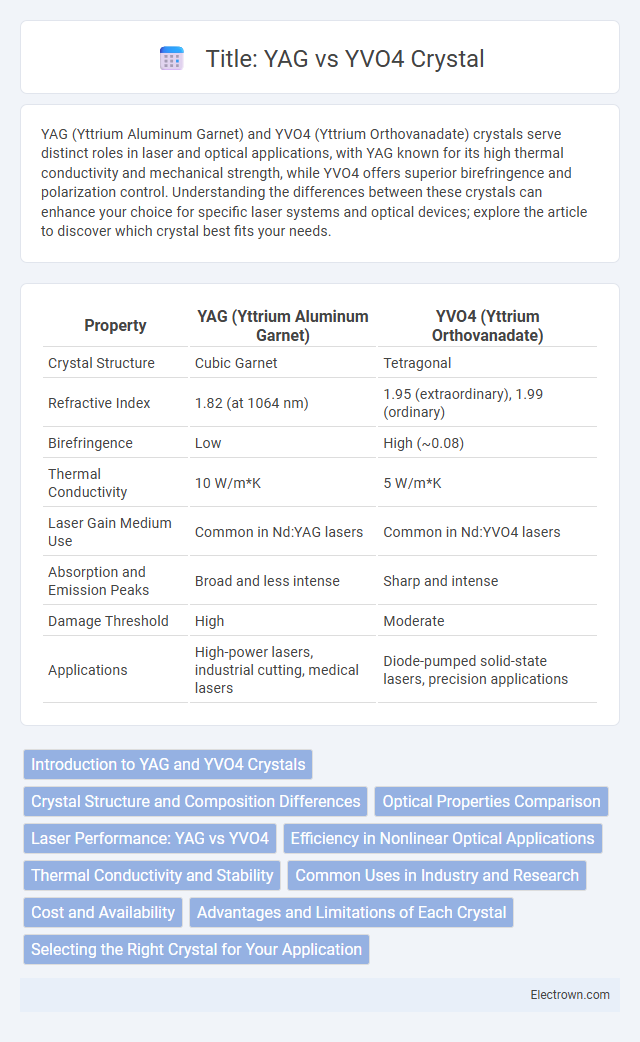YAG (Yttrium Aluminum Garnet) and YVO4 (Yttrium Orthovanadate) crystals serve distinct roles in laser and optical applications, with YAG known for its high thermal conductivity and mechanical strength, while YVO4 offers superior birefringence and polarization control. Understanding the differences between these crystals can enhance your choice for specific laser systems and optical devices; explore the article to discover which crystal best fits your needs.
Table of Comparison
| Property | YAG (Yttrium Aluminum Garnet) | YVO4 (Yttrium Orthovanadate) |
|---|---|---|
| Crystal Structure | Cubic Garnet | Tetragonal |
| Refractive Index | 1.82 (at 1064 nm) | 1.95 (extraordinary), 1.99 (ordinary) |
| Birefringence | Low | High (~0.08) |
| Thermal Conductivity | 10 W/m*K | 5 W/m*K |
| Laser Gain Medium Use | Common in Nd:YAG lasers | Common in Nd:YVO4 lasers |
| Absorption and Emission Peaks | Broad and less intense | Sharp and intense |
| Damage Threshold | High | Moderate |
| Applications | High-power lasers, industrial cutting, medical lasers | Diode-pumped solid-state lasers, precision applications |
Introduction to YAG and YVO4 Crystals
YAG (Yttrium Aluminum Garnet) and YVO4 (Yttrium Vanadate) crystals each possess unique optical properties critical in laser technology and photonics. YAG crystals exhibit high thermal conductivity and mechanical strength, making them ideal for solid-state lasers and frequency doubling applications. YVO4 crystals offer superior birefringence and polarization control, enhancing your system's efficiency in laser modulation and beam shaping.
Crystal Structure and Composition Differences
YAG (Yttrium Aluminum Garnet) features a cubic crystal structure composed of Y3Al5O12, providing high thermal conductivity and mechanical strength. YVO4 (Yttrium Orthovanadate) has a tetragonal crystal system with the chemical formula YVO4, known for its high birefringence and optical anisotropy. Your choice between YAG and YVO4 crystals depends on the specific optical and structural properties required for your laser or photonics application.
Optical Properties Comparison
YAG (Yttrium Aluminum Garnet) and YVO4 (Yttrium Orthovanadate) crystals exhibit distinct optical properties critical for laser applications. YAG boasts a higher thermal conductivity (approximately 14 W/m*K) and a cubic crystal structure, offering uniform refractive indices (~1.82 at 1064 nm) ideal for high-power laser operation. YVO4, with a birefringent tetragonal structure and higher refractive indices (n_o ~1.96, n_e ~2.17 at 1064 nm), provides superior polarization control and greater electro-optic coefficients, making it favorable for applications requiring precise beam polarization.
Laser Performance: YAG vs YVO4
YAG (Yttrium Aluminum Garnet) crystals exhibit high thermal conductivity and damage threshold, making them ideal for high-power laser applications with superior beam quality and stability. YVO4 (Yttrium Orthovanadate) crystals offer higher gain, larger stimulated emission cross-section, and strong polarization properties, resulting in more efficient laser performance in low to medium power diode-pumped solid-state lasers. The choice between YAG and YVO4 depends on the required laser power, beam quality, and application-specific efficiency.
Efficiency in Nonlinear Optical Applications
YAG (Yttrium Aluminum Garnet) crystals exhibit high thermal conductivity and mechanical strength, making them efficient in nonlinear optical applications requiring robust performance under high power. YVO4 (Yttrium Orthovanadate) crystals offer superior nonlinear coefficients and birefringence, resulting in higher frequency conversion efficiency and enhanced phase matching capabilities. The choice between YAG and YVO4 depends on the specific application's demand for thermal management versus nonlinear conversion efficiency.
Thermal Conductivity and Stability
YAG (Yttrium Aluminum Garnet) crystals exhibit higher thermal conductivity, typically around 14 W/m*K, enabling efficient heat dissipation in high-power laser applications. YVO4 (Yttrium Orthovanadate) crystals have lower thermal conductivity, approximately 5 W/m*K, which limits their performance under intense thermal loads. YAG also provides superior thermal and chemical stability, maintaining structural integrity at temperatures above 1900degC, whereas YVO4 degrades more rapidly under similar thermal stress.
Common Uses in Industry and Research
YAG (Yttrium Aluminum Garnet) crystals are widely used in high-power laser applications, including solid-state lasers for cutting, welding, and medical treatments due to their excellent thermal conductivity and durability. YVO4 (Yttrium Orthovanadate) crystals are preferred in optoelectronics and laser systems, especially for diode-pumped solid-state lasers, because of their high birefringence and efficient polarization control. Both crystals find significant roles in spectroscopy, nonlinear optics, and laser technology research, with YAG favored for high-energy pulses and YVO4 for precision polarization applications.
Cost and Availability
YAG (Yttrium Aluminum Garnet) crystals are generally more expensive due to their complex manufacturing process and widespread use in high-performance laser applications, which drives demand and production costs. YVO4 (Yttrium Orthovanadate) crystals are typically more affordable and easier to produce, making them readily available for various laser systems, particularly in compact and cost-sensitive applications. The availability of YVO4 is higher in bulk quantities, whereas YAG's supply can be limited depending on the required crystal size and doping specifications.
Advantages and Limitations of Each Crystal
YAG (Yttrium Aluminum Garnet) crystals offer high thermal conductivity and mechanical strength, making them ideal for high-power laser applications but exhibit lower birefringence compared to YVO4 (Yttrium Orthovanadate). YVO4 crystals provide superior birefringence and higher anisotropy, leading to better polarization control and efficiency in diode-pumped solid-state lasers, though they have lower thermal conductivity and are more brittle. The choice between YAG and YVO4 hinges on balancing thermal management needs with optical performance requirements in laser systems.
Selecting the Right Crystal for Your Application
YAG (Yttrium Aluminum Garnet) and YVO4 (Yttrium Orthovanadate) crystals differ significantly in optical properties, influencing their suitability for laser and nonlinear optical applications. YAG offers high thermal conductivity and mechanical strength, making it ideal for high-power laser systems and solid-state lasers requiring durability. YVO4 provides superior birefringence and higher nonlinear optical coefficients, preferred in applications demanding efficient frequency conversion and polarization control.
YAG vs YVO4 crystal Infographic

 electrown.com
electrown.com